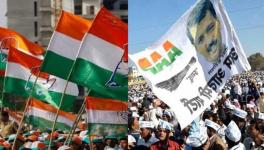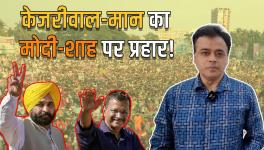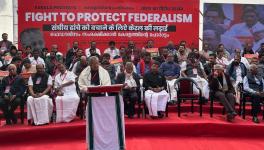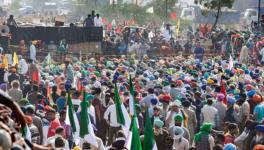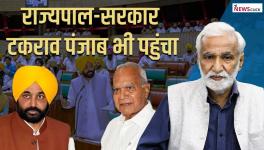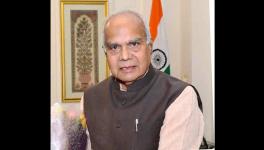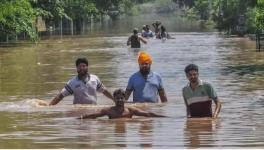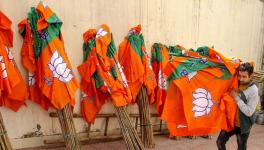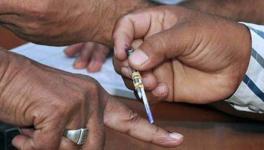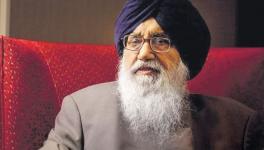Jalandhar By-poll Message for Parties: Dalits Not Captive Vote Bank
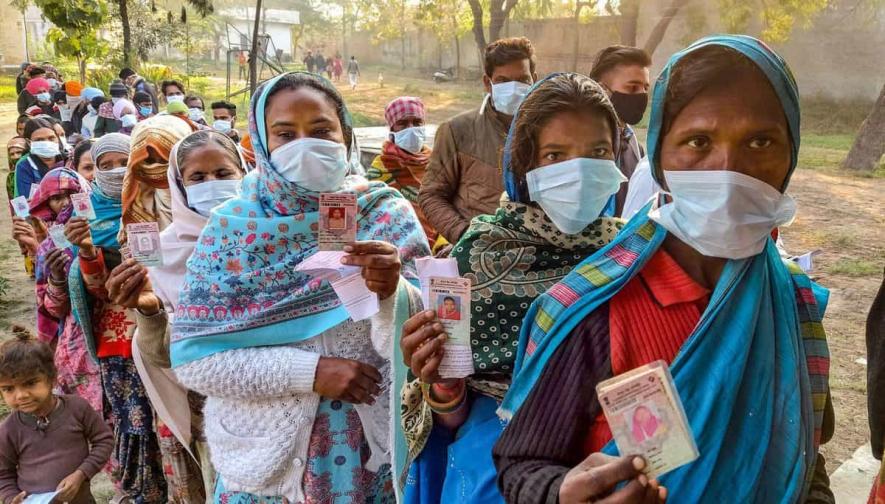
Women holding their identification cards, stand in a queue to cast their votes, during the Punjab Assembly elections, in Bathinda, Sunday, Feb. 20, 2022. Image Courtesy: PTI
These days, every political party in Punjab is busy with the Jalandhar Lok Sabha by-election contest scheduled for 10 May. This reserved seat is in the Doaba region, which has a significant Dalit population. As political experts busily guess what is on Dalit voters’ minds, we must survey Dalit politics in Punjab as a whole, not just in the Jalandhar Lok Sabha constituency. This is especially necessary because the Dalits of Punjab have never voted for any one party. Punjab has about 33% Dalit population, the highest among states, which in rural areas can reach 37%, and in parts of Doaba, 50%.
However, Dalit communities in Punjab are divided into 39 castes, whose interests often clash. The primary Dalit castes are the Ramdasiye, Ravidasiye, Mazhabi, Valmiki, Bhagat and Kabirpanthi. The Jatavs and Mazhabi Sikhs are in large numbers in the expansive Malwa region. Most religious Sikhs and Christians are Dalits in the Majha region. And the Jatav and Valmiki groups are in large numbers in the Doaba region.
It is generally believed that the Jatav voters mainly support the Congress party, while the Valmiki and religious voters support the Akali Dal, the Bahujan Samaj Party (BSP) and others. But the Aam Aadmi Party (AAP) victory in the 2022 Assembly election has challenged this perception. In 2022, even though the Congress party picked Charanjit Singh Channi as chief minister from a Dalit community, it won only nine of 23 Assembly seats in Doaba, while AAP won 10.
Kanshi Ram, who founded the BSP in 1984 to represent Dalits in politics, had a Punjab connection, so that BSP’s history and perceptions about it also matter in Punjab. Kanshi Ram was from the Rupnagar district, and his party’s candidate, Harbhajan Singh Lakha, won the Phillaur Lok Sabha seat in 1989 in collaboration with the Shiromani Akali Dal (SAD). It also won one seat in the 1991 Lok Sabha election, Mohan Singh’s from the Ferozepur constituency. (Due to the deteriorating situation in Punjab, those elections were held with the Assembly election in 1992.) But the BSP’s best-ever performance in Punjab was in 1992 when it won 9 seats and became the Opposition party. The SAD boycotted that poll.
In 1995, the Akali Dal aligned with the BSP in the by-election to the Gidderbaha Assembly constituency in the Bathinda district. It was the first election for Akali candidate and former Punjab finance minister Manpreet Singh Badal—Parkash Singh Badal’s nephew—which he won after a tough fight. In 2010, the Akali Dal expelled Manpreet after a dispute, and he formed the People’s Party of Punjab. In 2016, Manpreet merged his party with the Congress, and still later, he joined the Bharatiya Janata Party (BJP).
In the 1996 Lok Sabha election, the Akali Dal and the BSP allied again and won 11 of 13 seats in Punjab. The Akali Dal scored eight, the Congress two, and the BSP three—Kanshi Ram at Hoshiarpur, Mohan Singh at Ferozepur, and Lakha at Phillaur.
Months later, without informing the BSP, the Akali Dal joined hands with the BJP and severed its ties with the BSP, upsetting Kanshi Ram very much. The Akali Dal had unconditionally supported the BJP at the Centre, and they jointly contested the 1997 Assembly election, an alliance they projected as a symbol of Sikh-Hindu unity. The coalition came to power with 93 seats (75 for the Akali Dal and 18 for the BJP), crushing the Congress with just 14 seats, and leaving the BSP with only one. Many Dalit groups and parties broke away from the BSP at this point, including the Bahujan Samaj Morcha (BSM) of Satnam Singh Kainth, for which the SAD left the Phillaur Lok Sabha seat in the 1998 and 1999 elections.
In the 1998 Lok Sabha election, Satnam Singh became Member of Parliament by winning from Phillaur. In the 2002 Assembly election, the Akali Dal left two seats for his BSM, but it lost both. Later, Satnam Singh merged his party with the Congress. The BSP won no seat in the 2002 Assembly election though it had a 5.69% vote share. And in the 2007 Assembly election, it secured 4.13% votes, followed by 4.29% in the 2012 Assembly election. In the 2017 Assembly poll, the AAP and other parties dented BSP votes, dragging its share to 1.52%.
The BSP fought the 2019 Lok Sabha election as a part of the multi-party Punjab Democratic Alliance and improved its vote share to 3.5%, getting 1.46 lakh votes from the Anandpur Lok Sabha seat, more than 1.28 lakh in Hoshiarpur and more than 2 lakh votes in Jalandhar.
But in Punjab, BSP supremo Mayawati has often been accused of giving Uttar Pradesh more attention while paying lip service to Punjabi voters—and playing friendly matches with the bigger parties.
In the 2022 Assembly election, after a 25-year gap, the SAD forged a relationship with the BSP again. Its leaders said their alliance would outlast that election, since they share an ideology and would work for farmers, Dalits and farm labourers. But the Akali Dal faced a historic defeat in that election, winning just three seats and losing veteran leaders’ seats, including of Badal, Sukhbir Badal and Bikram Singh Majithia. Of Punjab’s 117 Assembly seats, the Akali Dal contested 97 and BSP 20—and BSP’s vote bank suffered a setback compared with the 2019 Lok Sabha election—it got only 1.77% of the votes. Yet it managed to enter the Assembly after 25 years (since 1997). In this election, many political experts, leaders and supporters of the BSP alleged that most seats in BSP’s share were general, not reserved, and that the Akali Dal handed it seats it felt it would have lost. In many places, it was said the BSP’s voters supported Akali Dal candidates, while the Akali Dal did not transfer votes to BSP candidates.
Which brings us back to the Jalandhar Lok Sabha by-election. The Akali Dal and BSP are now back to contesting together, with the Akali Dal’s Dr Sukhwinder Kumar Sukhi, MLA from the Banga Assembly constituency, as the candidate. Sociologist Prof Bawa Singh does not seem to expect much from this alliance. He says, “The peasant struggle had exposed the traditional parties of Punjab. That is why they made opportunistic alliances in 2022. The Akali Dal has faded from the people’s hearts for abandoning its old principles, like standing up for minorities, protecting the federal structure, etc.”
In short, the impression is that after breaking its alliance with the BJP, the Akali Dal has sought to make up for the loss with Dalit votes. It is a perception political commentator Pyarelal Garg would seem to back. He says, “The 1996 Akali Dal-BSP alliance seemed natural in a Punjab emerging from terrorism. But now, it seems opportunistic, as both parties are marginalised. It would be wrong to say they are fighting for Sikh-Dalit unity and federal interests.” He also points to the crucial issues that concern Dalit voters. While it is believed the Dalits in Punjab are better off than in many other states, for Sikhism does not support caste, yet, says Garg, we cannot “turn away from some bitter truths of the present and past”. He refers to the discrimination against Dalits at Harmandir Sahib in the early 20th century when Dalits had to endure separate visiting hours and segregated bathing spaces. The priestly class of mahants, assisted by the British, refused to accept offerings from Dalits nor prayed for them, and the Sikh brotherhood had to struggle against this for a long time.
Punjabi writer Balbir Madhopuri has observed in The Punjabi Tribune (25 June 2020) that when “Adi Dharma” was registered as a new religion in Punjab before the 1931 Census, the Hindus and Sikhs considered it an insult. They could not imagine those enslaved for centuries could become their equals. Former untouchables were ostracised and attacked at various places in Punjab at the time, and many Dalits who declared their religion “Adi Dharma” in the Census were killed.
Madhopuri, who wrote Chhangya Rukh, an excellent autobiography of the discrimination against Dalits in Punjab, tells me, “The lower castes in Punjab have recovered somewhat economically after independence, but the battle against social inequality is yet to come. From a young age, I have seen and suffered atrocities like untouchability, Dalits being denied entry into Gurdwaras, the physical abuse of Dalit women, etc.”
In Punjab, there are still reports of the prohibition of Dalits in many gurdwaras, which is why separate gurdwaras and deras were built. Even now, Dalits have different cremation grounds, and gurdwaras announce their social boycott. Further, even Dalit society is internally a victim of high and low [status], he says.
“Social inequality towards Dalits is an important issue in Punjab,” Madhopuri says, and so is their economic exclusion and disparity. For example, the rates of sowing paddy are fixed by wealthy farmers, who are invariably non-Dalits. If the Dalit workers oppose this, they face social boycotts, including from local leaders of major parties. “No Dalit organisation or party, except the leftist organisations, ever joined the Dalit struggle for economic demands,” he says, adding, “An important battle in this is the one-third share for Dalits in panchayat land, which they often do not get—Left organisations have fought a long battle in the Malwa region for this right,” he says.
Mukesh Malod of the Zameen Prapti Sangharsh Committee tells me, “The Akalis and the Congress opposed our struggle, but many Dalit organisations also did not stand with us. The role of the BSP was also very negative.” In 2014, elite-caste members in Balad Kalan village in the Sangrur district boycotted Dalits, prompting them to associate with the AAP. They had hoped Bhagwant Mann (the current chief minister and Member of Parliament from Sangrur at the time), would rectify the situation by fulfilling their just demands. Though their issues were raised in the Lok Sabha, Mann, too, did not solve their problems. In 2016, he was silent when Dalits were boycotted in the Jalur village of Sangrur. Malaud says some AAP-leaning people in his organisation called Mann to meet and resolve their issues, he told them the Jatt votes would leave him.
Tarsem Peter, a Dalit activist in the Doaba and Majha regions, says, “Like the land issue in Malwa, residential plots for Dalits are a big concern in Doaba. Previous governments promised them this, but did not fulfil it. In many places, Dalits who raised this demand were socially boycotted. Cooperative loan waivers for Dalits are also a significant concern.” Peter explains that identity is an essential issue among Dalits in the Doaba. It has many temples and gurdwaras that depict Dalit identity, and often, Dalit deras have clashed with extremist Sikh groups, such as the one that led to the killing of Sant Ramanand of the Dera Ballan in Jalandhar.
Although the problems of Dalits in the Majha region are similar, large number of Christian Dalits await their demand for a graveyard to be fulfilled. This is also an important issue for Christian Dalits who live in large numbers in Doaba. A Christian party formed in recent times has reiterated this demand.
Recently, Amritpal Singh, his companions and other extremist Sikh organisations accused Christian priests of forcibly converting Dalit Sikhs. These Sikh organisations tried to stop Christian religious ceremonies and took violent actions. The stalled scholarships for Dalit students are another crucial issue in Punjab—a minister in the previous Punjab government was a target of opposition parties over allegations of delayed stipends. This issue was raised even during the Akali government.
The renowned political scientist of Punjab, Ronki Ram, says, “All political parties have been looking at Dalits as a vote bank. The Akalis also started schemes like the Atta-Dal and Shagun schemes to attract Dalit votes, but later, irregularities were discovered in them. Today, the Akali Dal discusses the rights of Dalits, but during the 2007 dera dispute, its workers were socially boycotting Dalits.”
The author is an independent journalist. The views are personal.
Get the latest reports & analysis with people's perspective on Protests, movements & deep analytical videos, discussions of the current affairs in your Telegram app. Subscribe to NewsClick's Telegram channel & get Real-Time updates on stories, as they get published on our website.









